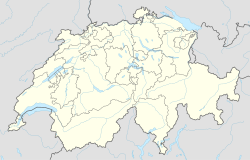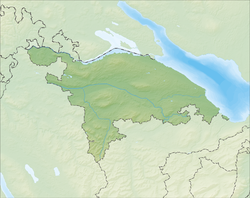Bürglen, Thurgau
| Bürglen | ||
|---|---|---|
 |
||
|
||
| Coordinates: 47°33′N 9°9′E / 47.550°N 9.150°ECoordinates: 47°33′N 9°9′E / 47.550°N 9.150°E | ||
| Country | Switzerland | |
| Canton | Thurgau | |
| District | Weinfelden | |
| Area | ||
| • Total | 11.68 km2 (4.51 sq mi) | |
| Elevation | 441 m (1,447 ft) | |
| Population (Dec 2015) | ||
| • Total | 3,690 | |
| • Density | 320/km2 (820/sq mi) | |
| Postal code | 8575 | |
| SFOS number | 4911 | |
| Surrounded by | Berg, Birwinken, Bussnang, Kradolf-Schönenberg, Schönholzerswilen, Sulgen, Weinfelden | |
| Website |
www SFSO statistics |
|
Bürglen is a municipality in the district of Weinfelden in the canton of Thurgau in Switzerland.
Bürglen is first mentioned in 1282-84 as Burgelon. A Freiherr of Bürglen is first mentioned in 1176. By 1350, the land around the village had all been brought under a single noble and became the Herrschaft of Bürglen. Then, in 1408, the Herrschaft was acquired by the Lords of Klingenberg. The land transferred in 1443 to Marquart Brisacher from Constance and then in 1447, it went to the Baron of Sax-Hohensax. That family had owned in property in Bürglen since 1360. By 1500 they had built it up to become the center of their power. However, in 1550 they had to sell it to the Breitenlandenberg family, who, in turn, ceded it in 1579 to the city of St. Gallen. The village was managed, until 1798, by a St. Gallen appointed Vogt. The Vogt ruled over the low court of Bürglen, Uerenbohl, Guntershausen (now Guntershausen bei Berg), Heldswil, Mettlen and Istighofen and parts of Hüttenschwil and Sulgen. In addition, after 1580 it included Mühlebach (now Mühlebach bei Amriswil), followed in 1647 by Bleiken, in 1664, Hessenreuti and finally in 1665, Amriswil.
Even though the village was fortified around 1300, it was never considered a city. This was due to the decline of the Baron and competition from other neighboring villages. After the disastrous fire in 1528, the villagers went into debt to the Herrschaft for the reconstruction of the village. To help pay off the debt, in 1540 they granted the Herrschaft rights to the common land. Under St. Gallen, the village lost most of their autonomy. St. Gallen appointed the Ammann and the chairman of the Lower Court, promoted the settlement of its citizens to form a local elite, and changed the succession order in inheritances. However, the local farmers enjoyed a certain independence, and in the 17th Century they promoted the expansion of the castle as well as the creation of new businesses. This relative prosperity was followed in the 18th Century, by a government practice that hindered the formation of viable village government and led to general impoverishment.
...
Wikipedia




